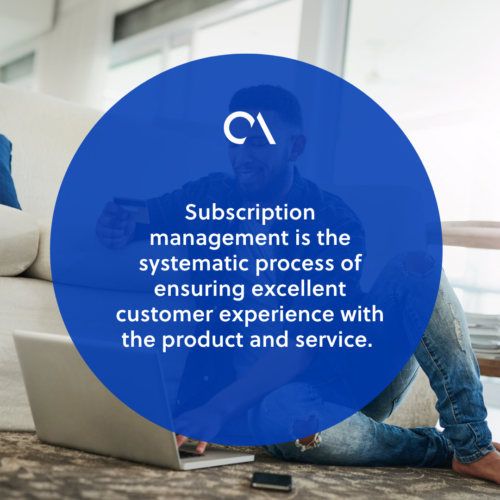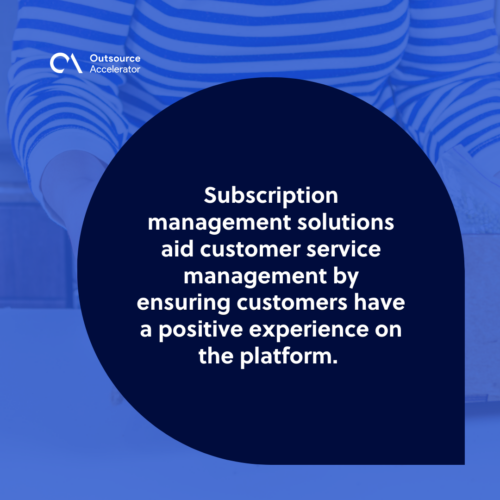Complete guide to subscription management

Entering the subscription business is challenging. It comes with the perpetual promise to improve, satisfy and empower the user.
Be it a content platform or an office tool, the subscribed product should always live at par with the expectations established at the onset.
But not all promises are guaranteed to become reality. Even the usage of the subscribed products does not promise a 100% seamless experience.
Hence, it becomes crucial to manage and enter into subscription management services.
But what is subscription management? How does it work? What are the various payment schemes companies can consider when employing?
All of these and more are in the sections below.
What is subscription management?
Subscription management is the systematic process of ensuring excellent customer experience with the product and service.
The entire process starts when the customer subscribes to the product or service and ends during cancellation.
The management of subscriptions only becomes complicated with the various technical glitches and problems with the product and software introduced to the market.
The strength of subscription management solutions is it enables companies to explore and pursue innovative business models by providing various ownership options, such as:
- Providing access to goods and services which are otherwise too expensive for customers.
- Customizable bundling options of products and services that meet the needs and demands of clients.

How does a subscription management solution work?
Subscription management solutions aid customer service management by ensuring customers have a positive experience on the platform.
Be it for renewal purposes, complaints, or even upgrades, the technology enables the brand to forge a better relationship with its end users.
The good thing with subscription management technology is that data and technology-abled processes power it.
This way, when a bill is sent, the companies are assured that customers have paid what was owed.
To better understand subscription management, this is how it works:
Customers choose and pay online for B2B products
It is easier to add new products and subscription plans to the existing ones with the option to customize pricing and payment scheme.
This is facilitated through self-service channels like company websites or applications. Online support is available to guide end-users with their preferred plans.
Closing deals is faster with online sales rep support
Changing subscription plans happens all the time due to various reasons. With too many requests simultaneously placed, staying accurate and detailed becomes a challenge.
The good thing with subscription management apps is that sales reps can change quantities and make the necessary changes through the application.
They can create better pricing plans based on customer preferences without forcing the end user to shell out huge amounts of money on the get-go.
Nurturing leads and rapport becomes easy
With customers comfortable with the self-service channels and applications, sales reps can make regular updates and follow up with the users.
Upgrades and renewals become a lot easier. At the same time, they get across important insights onto customer purchase patterns that will inform their new pricing plans.

Why is subscription management important?
The real success of companies engaged in subscriptions is the continuous renewal and upgrade of their end users. The more consistent the trend is, the more growth the company is experiencing.
The key to unlocking this is consistently communicating with customers. The closer the brand is to its end users, the more they feel they are valued. As a result, they will continue to patronize and make active transactions.
This rapport is crucial since, in recurring business models such as subscriptions, retaining customers is the name of the game.
Poor performance and management of their expectations can lead to subscription cancellations. Other benefits are the following:
Augmenting customer experience
In the new market landscape characterized by digital transactions, defining the customer experience and journey is crucial.
All initiatives should be directed to enabling customers. The more interaction the brand has with its end users, the happier they become.
Customer retention is important
One of the main strengths of subscription management is it empowers the customer to customize their plans.
They create their accounts, build their own plans, and choose the most convenient payment scheme they can accommodate.
They also have the option to interact with sales representatives whenever they encounter problems or glitches in the platforms.
This one-stop-shop platform offers a lot of convenience and interoperability at the end-users disposal.

Common subscription pricing models
There are various subscription pricing models in the market. Each brand has developed its own pricing schemes.
Each model has its unique scheme, depending on the specific purpose it is directed towards.
Some of the most common pricing models are as follows:
- Static pricing – standard pricing is used across all products based on the price book.
- Consumption pricing – is based on the amount of usage customers avail. This is similar to retail loads wherein each gigabyte has a corresponding amount.
- Contracted pricing – this kind of pricing is pre–negotiated. This allows end users to have their own package and not contact sales reps.
Other pricing models are customized based on the needs and means of the organizations and/or individuals.






 Independent
Independent




